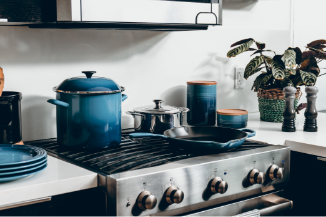
“Choose your friends wisely” says a well known adage. Would this hold true even in the kitchen?!
Some of the most basic cookware used in the kitchen are pots and pans such as a saucepan, a sauté pan, a pressure cooker and a casserole for baking. As you start spending more time in the sacred space of your kitchen, you are sure to develop a relationship with your cooking paraphernalia, especially your pots and pans. They become your buddies and help you cook the right food, in right quantities.
A couple years ago when I was out shopping at a supermarket to buy pots and pans, I was overwhelmed with the sheer number of choices available of different types, makes and brands. It was then I decided to do some research and shortlist my options. To my surprise and dismay, the most attractive and beautiful looking pots and pans namely glazed ceramic, non-stick, hard anodized were all rated non-healthy! Knowing this, I selected to buy a set of stainless steel pots and pans.
Isn’t this also a fundamental principle to choose your friends? You generally chose your friends based on the internal impact they have in your life and not just based on how beautiful they look. So let us browse through the list with a brief explanation as to why and how can we make right choices to avoid inflow of non favorable materials into our bodies.
Prefer
Cookware made of inert and non-reactive materials:
1. Stainless steel:
Apart from being inert, stainless steel cookware is easy to maintain – a great feature for everyday cooking
2. Glass:
Glass is great to use as a bake ware
3. Iron:
Fortifies food with iron and is very affordable
4. Non glazed clay:
Traditional (Non glazed) clay cookware impart a very rich flavor to the food
Avoid
1. Non-stick / Non-stick coated ceramic pots, knives:
Non-stick cookware is made using a carcinogenic chemical called perfluorooctanoic acid (PFOA), which starts emitting toxic fumes that you inhale every time you cook with a non-stick pot or pan! Especially when scratched, it can leach this toxic chemical directly into the food. These toxins accumulate in your body as they are hard to get out. Many experts say PFOA increases the risk of cancer, high cholesterol, thyroid & infertility.
2. Aluminum:
Aluminum is a “reactive” metal, meaning that it reacts with salty or acidic foods to release itself into your food. The agency for toxic substances and disease registry has clearly identifies aluminum as a toxin for human nervous system, immune system and genetic system. Once ingested, traces of aluminum stay in your body.
3. Glazed clay:
Pots and pans are usually glazed with lead based paints which leaches into the food. Lead is very well-known for its toxicity.
4. Plastic:
Plastic is most damaging to environment and to health. Most plastics leach hormone like chemicals few of which are Bisphenol (BPA), Polyvinyl chloride (PVC) and phthalates. BPA has been linked to Cancer, Poor brain function and some heart risks. Studies have also found hormone like chemicals even in products that didn’t contain BPA, hence it is best to avoid plastic.
Tips
1. Cast iron griddles are one of the best alternative to non-stick surfaces and it can probably last for generations of your family
2. Use unbleached parchment paper while using your non-stick / aluminum bake ware to avoid leaching of chemicals into your food while baking.
3. When packing warm bread / flatbreads / patties or for your meal in aluminum foil, separate it by using unbleached parchment paper to avoid direct contact with aluminum
Sources
http://www.foodsafetynews.com/2011/04/several-months-ago-gerald-omalley/#.WbVG0GVllPM
http://www.npr.org/2011/03/02/134196209/study-most-plastics-leach-hormone-like-chemicals


